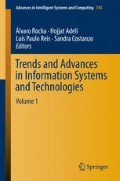Abstract
Urban centers attractive for local citizens commonly house local cuisine restaurants or commercial areas. Local authorities are interested in discovering pattern to explain why city residents go to different areas of the city at a given time of the day. We explore a massive dataset of taxi rides, 69 million records in New York city, to uncover attractive places for local residents when going to Brooklyn. First, we obtain the origin destination matrix for New York boroughs. Second, we apply a density based clustering algorithm to detect popular drop-off locations. Next, we automatically find the closest venue, using the Foursquare API, to the most popular destination in each cluster. Our methodology let us to uncover popular destinations in urban areas in any city for which taxi rides information is available.
Access this chapter
Tax calculation will be finalised at checkout
Purchases are for personal use only
Notes
- 1.
NYC Taxi and Limousine Commission (TLC): http://www.nyc.gov/html/tlc/html/about/trip_record_data.shtml.
References
Comito, C., Falcone, D., Talia, D.: Mining human mobility patterns from social geo-tagged data. Pervasive Mob. Comput. 33, 91–107 (2016)
Corcoran, J., Li, T., Rohde, D., Charles-Edwards, E., Mateo-Babiano, D.: Spatio-temporal patterns of a public bicycle sharing program: the effect of weather and calendar events. J. Transp. Geogr. 41, 292–305 (2014)
Ferreira, N., Poco, J., Vo, H.T., Freire, J., Silva, C.T.: Visual exploration of big spatio-temporal urban data : a study of New York City cab trips. IEEE Trans. Vis. Comput. Graph. 19(12), 2149–2158 (2013)
Hong, S., Lee, K., Rhee, I.: STEP: a spatio-temporal mobility model for humans walks. In: 2010 IEEE 7th International Conference on Mobile Adhoc and Sensor Systems, MASS 2010, pp. 630–635 (2010)
Hoque, M.A., Hong, X., Dixon, B.: Analysis of mobility patterns for urban taxi cabs. In: 2012 International Conference on Computing, Networking and Communications, ICNC 2012, pp. 756–760 (2012)
Kumar, D., Wu, H., Lu, Y., Krishnaswamy, S., Palaniswami, M.: Understanding urban mobility via taxi trip clustering. In: Proceedings - IEEE International Conference on Mobile Data Management, July 2016, pp. 318–324 (2016)
Liang, X., Zheng, X., Lv, W., Zhu, T., Ke, X.: The scaling of human mobility by taxis is exponential. Phys. A Stat. Mech. Appl. 391(5), 2135–2144 (2012)
Luo, F., Cao, G., Mulligan, K., Li, X.: Explore spatiotemporal and demographic characteristics of human mobility via Twitter: a case study of Chicago. Appl. Geogr. 70, 11–25 (2016)
Nandan, N.: A grid-based approach for similarity mining of massive geospatial trajectories. In: Proceedings - 2014 IEEE International Conference on Computer and Information Technology, CIT 2014, pp. 765–768 (2014)
Ni, B., Shen, Q., Xx, J., Huamin, Q.: Spatio-temporal flow maps for visualizing movement and contact patterns. Vis. Inform. 1(1), 57–64 (2017)
Sajana, T., Rani, C.M.S., Narayana, K.V.: A survey on clustering techniques for big data mining. J. Sci. Technol. 9(3), 1–12 (2016)
Sen, R., Quercia, D., Gummadi, K.P.: Scalable urban data collection from the web. In: ICWSM, pp. 683–686 (2016)
Song, C., Zehui, Q., Blumm, N., Barabasi, A.-L.: Limits of predictability in human mobility. Science 327(5968), 1018–1021 (2010)
Wilmoth, J.: World population 2017.pdf. Technical report, Population Division, DESA, United Nations (2017)
Author information
Authors and Affiliations
Corresponding author
Editor information
Editors and Affiliations
Rights and permissions
Copyright information
© 2018 Springer International Publishing AG, part of Springer Nature
About this paper
Cite this paper
Garcia, J.C., Avendaño, A., Vaca, C. (2018). Where to go in Brooklyn: NYC Mobility Patterns from Taxi Rides. In: Rocha, Á., Adeli, H., Reis, L.P., Costanzo, S. (eds) Trends and Advances in Information Systems and Technologies. WorldCIST'18 2018. Advances in Intelligent Systems and Computing, vol 745. Springer, Cham. https://doi.org/10.1007/978-3-319-77703-0_20
Download citation
DOI: https://doi.org/10.1007/978-3-319-77703-0_20
Publisher Name: Springer, Cham
Print ISBN: 978-3-319-77702-3
Online ISBN: 978-3-319-77703-0
eBook Packages: EngineeringEngineering (R0)

